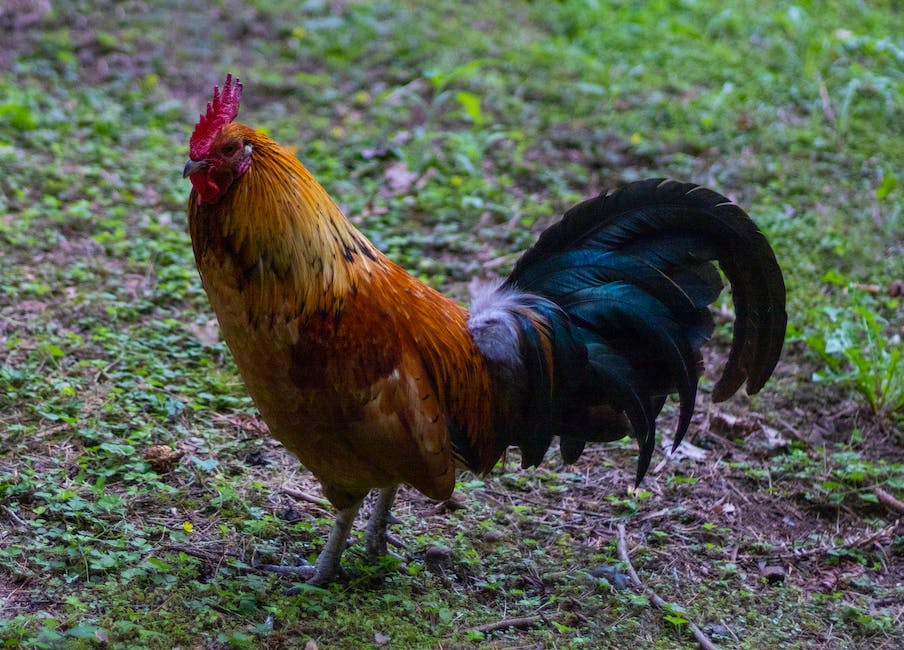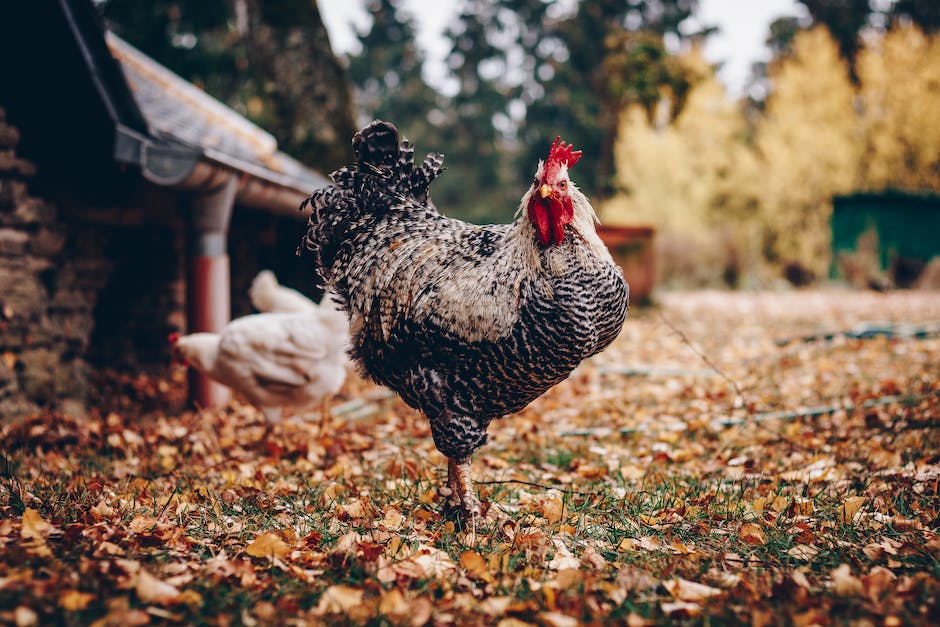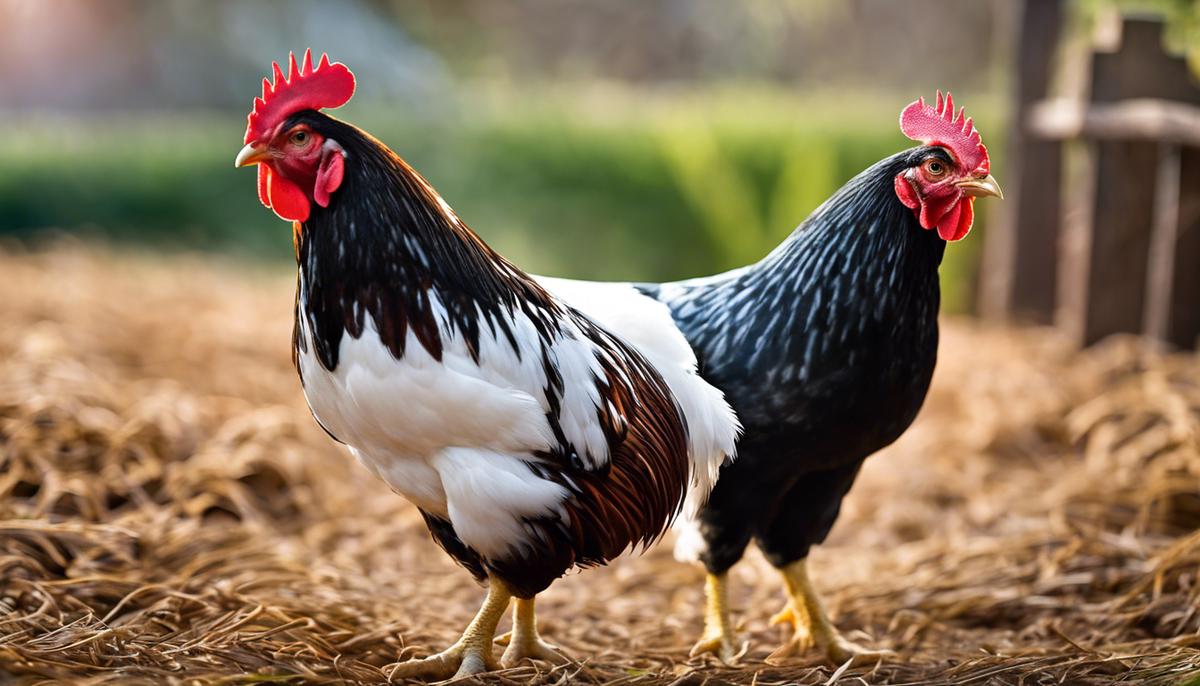

Agridisk
Egypt - Alexandria

Chicken poultry business & What is the best chicken for poultry business?
Description: As the demand for poultry products continues to soar alongside a swiftly growing global population, understanding the dynamics of the chicken poultry business becomes increasingly critical. The journey towards carving out a successful niche in this vigorous industry begins with a comprehensive market analysis, laying the groundwork with insightful evaluation of consumer behaviors, market demands, and forthcoming opportunities. Coupled with a foresight-driven approach, these insights pave the way for entrepreneurs to strategically steer their operations toward uncharted territories of growth and innovation. In the heat of today’s competitive business landscape, it's no longer enough to follow well-trodden paths and hope for meager leftovers. A savvy entrepreneur must possess the acumen to sniff out fresh opportunities while staying abreast of the latest market trends. Indeed, there's a smorgasbord of innovative strategies and tools out there for businesses looking to cook up success in their industries. First up, technology is the chef's special on the menu of modern success. A dash of AI here, a sprinkle of automation there, and a full serving of data analytics can transform a struggling business into a market leader. Intelligent automation streamlines operations, enabling companies to serve up efficiency and customer satisfaction. Meanwhile, data analytics provides the palate-cleansing insights necessary to understand consumer behavior and predict market trends. Let's not forget that sustainability is far from a mere garnish in the world of business; it is the main course driving consumer loyalty and investment interest. Companies integrating green practices are not only doing their part for the planet—they're also capitalizing on the growing appetite for eco-friendly products and services. This trend is a veritable feast for opportunity, relished by investors, and savored by consumers. Collaboration is another key ingredient that cannot be overlooked. In this era of hyper-connectivity, forming strategic partnerships across industries allows businesses to leverage strengths, mitigate weaknesses, and increase their market reach. This cross-pollination of ideas and resources cooks up innovative solutions, serving a competitive advantage on a silver platter. Serving niche markets is akin to a seasoned chef knowing exactly how to satisfy the palate of a discerning diner. In an overly saturated market, there are niche opportunities waiting to be claimed by those with the foresight to tailor their offerings. These markets are ripe with potential for high-profit margins and dedicated customer bases who feel understood and valued. Lastly, financial agility—a firm grasp on fiscal acrobatics—is essential for businesses looking to navigate the unpredictable waves of the market. Agility in funding, capital allocation, and cost management ensures that a business can pivot in any direction the market winds may blow, enabling them to land on their feet and stay ahead in the race. In sum, those wanting to serve up success in the current market conditions must embrace innovation, sustainability, collaboration, niche marketing, and financial agility. It's these deliciously dynamic strategies that promise to keep your business moving forward, gaining momentum with every bite of opportunity. Bon appétit, entrepreneurs! In today’s fiercely competitive marketplace, businesses must constantly innovate and refine their strategies in order to stay ahead of the curve. To out-cluck the competition—an idiom that conjures the image of an entrepreneur who is swift and vocal—companies must blend and expand upon traditional and modern business techniques. While technology serves as the backbone of modern commercial success, the core of innovation lies within a company's corporate culture. Fostering an environment that encourages creativity, embraces change, and rewards risk-taking is critical. Businesses that cultivate a dynamic corporate culture position themselves to leapfrog competitors by quickly capitalizing on new opportunities and swiftly adjusting to market shifts. Customer experience is king, and mastering this domain requires a deep understanding of consumer behavior. Leverage the latest in social media trends, experiential marketing, and omnichannel sales approaches to engage with your target audience on a profound level. By creating a meaningful and emotive connection with your clientele, brand loyalty can skyrocket, forging a protective bulwark against the encroachments of competitors. Generic approaches are a thing of the past. Today’s customers crave personalization. Harnessing big data and predictive analytics allows businesses to tailor their offerings to individual consumers with precision. This hyper-personalized strategy not only increases customer satisfaction but also optimizes resource allocation, ensuring that efforts are focused on high-yield areas. Efficiency wins races. Streamlining operations not through cost-cutting but by process optimization is key. Incorporate lean methodologies to eliminate waste and improve the quality of products and services. An organization that operates like a well-oiled machine not only saves on unnecessary expenses but also delivers value more rapidly and reliably than its contenders. Innovation breeds imitation. To maintain your competitive edge, it is imperative to protect your intellectual property (IP). Establish a robust IP strategy that includes patents, trademarks, and copyrights, creating a barrier against replication. These legal protections can serve as a deterrent to competitors and become a cornerstone of your venture's valuation. In a world of who-knows-whom, leverage your professional network to create opportunities and synergies that were previously untapped. Building connections and sharing knowledge across industries can spark ideas that become the next game-changing products or services. Also, an entrepreneur’s ability to connect with thought leaders, potential investors, and skilled professionals can accelerate growth exponentially. Your workforce is your artillery. Investing in the development of your team's skills and talents ensures you remain at the forefront of innovation. Encourage continuous learning and offer opportunities for professional growth. A well-educated, highly skilled team will not only optimize current operations but will also be the incubator for the ground-breaking ideas of tomorrow. Finally, agility in business doesn't just require responding to today's trends but anticipating tomorrow's. Having a strategic foresight capability within your enterprise can pay dividends. By scanning the horizon for emerging trends and disruptions, you can position your business to lead rather than follow, turning potential threats into profitable ventures. Ahead, the entrepreneurial journey continues without rest. With these strategies in hand, set your sights on out-clucking the competition. Stay perceptive, stay proactive, and most crucially, stay ahead. Navigating the world of regulation and compliance can often be perceived as either a cumbersome blockade or an empowering safeguard, depending on the vantage point of the beholder. For the shrewd entrepreneur, understanding and maneuvering through this labyrinth of red tape can indeed be both a blessing and a curse. Red tape, those administrative regulations and formal rules that govern business operations, represents a critical frontier requiring strategic navigation. On one hand, it necessitates a meticulous approach to compliance and due diligence, mitigating risks that could potentially derail an enterprise. On the other, it can throttle agility, stymie innovation, and impose a hefty cost burden. However, it's crucial to recognize that regulatory frameworks also serve as a vanguard, protecting your brand's integrity and consumer trust. Companies that excel in regulatory compliance harness its potential by leveraging it as a competitive edge, showcasing their commitment to legal and ethical standards. Building a reputation on this foundation can galvanize consumer confidence and lay down the roots of brand loyalty, a currency of immeasurable value in today's market. Moreover, regulatory landscapes offer a pretext for businesses to analyze and streamline their processes. By rigorously examining the requirements laid out by these standards, leaders can identify operational inefficiencies, redundancies, and areas ripe for optimization. This necessity-driven innovation can be the catalyst for breakthrough productivity, transforming a perceived constraint into a functional asset. What's more, the terrain of compliance constantly evolves, with regulatory bodies updating protocols to keep pace with technological advances and societal shifts. Keeping abreast of these developments is not optional; it's critical. By forecasting regulatory trends and preparing proactively, businesses not only safeguard themselves against potential penalties but also present themselves as forward-thinking and responsible entities. Efficient strategies to navigate the red tape may include implementing compliance management systems, engaging with legal experts, and actively participating in industry associations. These measures afford businesses a panoramical understanding of their compliance landscape, allowing them to position themselves deftly to adapt and comply. In essence, while red tape can seem daunting and at times antagonistic to the speed of business, it remains inextricably tied to the broader fabric of responsible, sustainable entrepreneurship. Entrepreneurs who confront regulatory challenges head-on, turning them into opportunities for improvement and credibility-building, will lead the charge in instilling a culture of compliance that transcends mere legality and becomes part and parcel of a robust, enduring brand image. Make no mistake—navigating the red tape is not just about legal conformity; it is about business survival, differentiation, and ultimately, triumph. In the dynamic world of poultry production, those at the helm of success know too well that beyond the barn lies a breed of opportunities ripe for the plucking. To hatch profit, savvy poultry entrepreneurs are constantly refining their supply chain strategies. Akin to an intricately woven nest, the efficiency of the supply chain is paramount in ensuring profitability. At the nucleus of these strategies is the implementation of robust biosecurity measures. In an industry susceptible to the whims of disease outbreaks, protecting flocks isn't mere prudence; it's an investment in continuity. Poultry titans are quick to adopt cutting-edge biosecurity technologies, creating impermeable fortresses against potential avian adversaries. Equally important is the foray into diversification. Not content with traditional product lines, industry pioneers expand into organic and free-range offerings, catering to the palate of a health-conscious consumer base. Diversification doesn't end at products; it includes expanding into ancillary services like hatcheries, feed production, and even rendering plants, ingeniously converting by-products into profits. Another feather in the cap of profit-orientated poultry magnates is their prowess in navigating global markets. Embracing export opportunities translates to tapping into emerging economies hungry for quality poultry products. By casting nets across oceans, these tycoons mitigate local market volatility and tap into the pulsating demand of international markets. Moreover, tapping into the direct-to-consumer trend allows for bypassing layers of middlemen. Selling directly via online platforms or through farmer's markets not only significantly boosts margins but also fosters brand loyalty and opens a channel for invaluable consumer feedback. It's a strategy that combines traditional farm wisdom with digital marketplace muscularity. Yet, amidst these myriad strategies, the real catch is industry foresight. It is about honing the ability to sniff out socioeconomic changes, adapt to consumer trends, and anticipate shifts before they become tidal waves that could threaten the balance of the business. Forward-thinking poultry kings and queens understand that to maintain a stronghold in this sector, one must be as nimble and alert as the animals they rear. The poultry industry is not for the faint-hearted, and transforming mere eggs into a golden nest egg is no serendipitous feat. It demands grit, insight, and a ceaseless quest for innovation. Those who crack the code of efficiency, biosecurity, diversification, global market penetration, and direct-to-consumer intimacy are the ones who rake in sustainable profits. Let it be clear, the poultry business, when done right, is not merely about the number of eggs in one's basket; it's about understanding the basket itself and the ever-changing market it caters to. And, for the poultry entrepreneurs who have mastered these realms, the profit is not just a potential but a given. In the highly competitive poultry industry, what truly makes a chicken brand stand out is the ability to create a memorable experience for consumers. Experiential marketing – that personal touch that transforms customers into brand ambassadors – is the golden egg of brand differentiation. Crafting an irresistible brand story is foundational. Storytelling isn't merely about the journey from farm to fork; it delves into the heritage, the dedication to quality, and the commitment to community that aligns with values-driven consumption. This isn't simply chicken; it's a piece of the story on the dinner table. Moreover, infusing culinary innovation into product development ensures that a brand keeps pace with gastronomic trends. From bold new flavors to healthy eating options, staying ahead means offering something that isn't just food, but a culinary experience. The visibility of a brand also hinges on its digital presence. A dynamic online platform, where interactivity is king, helps foster a community around the brand. Utilizing influencer partnerships and social media campaigns not only raises awareness but builds a narrative that resonates with the consumer zeitgeist. Additionally, crisis management is not just reactive but strategically anticipatory in nature. Protecting a brand against unforeseen events requires comprehensive risk assessment and a clear communication strategy, guaranteeing credibility remains intact when it matters most. Yet, amid the strategies and storytelling, never underestimate the power of pure, unbridled passion. The infectious energy of a team that believes deeply in what they're bringing to the market spreads faster than wildfire. It is the spark that lights the grill of innovation and keeps a chicken brand not just sizzling, but blazing. In the end, it's clear: the sizzle of a successful chicken brand comes not just from serving a product but from serving an experience, one that is rich in flavor, steeped in story, and bursting with innovation. Now, go out there, embrace the challenge, and set the market aflame with a brand that can't help but turn heads. Mastering the chicken poultry business is an endeavor that demands unwavering attention to detail and a proactive stance on emerging trends and practices. By arming oneself with a deep understanding of the regulatory framework, adopting financial acumen, and committing to powerful marketing and branding contrivances, poultry enterprises can transcend traditional agriculture paradigms. As the industry evolves, those at the helm of these businesses must too evolve, ever adaptable, ever resilient, and always forward-thinking to ensure their brand not only survives but thrives in the competitive poultry marketplace. In an ever-evolving world where consumer preferences shape the market, understanding the dynamics of the poultry industry becomes a paramount concern for individuals keen on venturing into the business. This endeavor is far from a one-size-fits-all model, with the choice of chicken breed, innovative farming techniques, and strategic networking all playing significant roles in determining success. As we delve into these aspects of the poultry business, we will shed light on the market forces at play, analyze the most profitable chicken breeds, uncover potential innovation opportunities, and underscore the importance of fostering robust business networks and resource bases. Driving Market Demand in the Poultry Industry: A Comprehensive Look It's no secret that market demand forms the lifeblood of every thriving industry. The poultry industry is certainly one of those that relies heavily on market demand. Understanding the driving forces behind this demand can help entrepreneurs spot untapped opportunities to innovate, expand, and secure a crucial competitive edge. One of the key drivers of demand in the poultry industry is rapidly changing consumer preferences. Today, consumers are becoming more conscious about their health, opting for lean meat as a source of protein, and poultry perfectly fits that bill. Poultry, particularly chicken, is perceived as a healthier alternative to other meats, thereby influencing demand positively. Moreover, the widespread availability and adaptability of poultry products equally dictate demand. Poultry meat can be easily incorporated into a variety of dishes, from burgers and sandwiches to salads and stews, thus accommodating different pallets. This flexibility boosts its popularity, hence its demand. At the core of the poultry industry, though, is price. Take chicken for instance, it remains one of the most inexpensive sources of protein available. When budget constraints come into play, consumers naturally opt for more cost-effective options, making poultry a go-to option. It's also important to acknowledge the role of cultural and religious considerations. Poultry, especially chicken and turkey, have a universal acceptance across various cultures and religions. This wide acceptance vastly increases their market demand. Finally, don't overlook the impact technology and innovation have on demand. Advancements in poultry farming techniques have not only improved yield, but have also significantly reduced costs. This, in turn, stabilizes supply and retail prices influencing market demand positively. Industry players, therefore, have a keen interest in understanding these market drivers. The insight gained gives them the ability to anticipate shifts in demand, adjust their strategies accordingly, and seize emerging opportunities to stay ahead. In a nutshell, market demand in the poultry industry is driven by a complex mix of factors. From consumer preferences and widespread availability, to cost, cultural acceptance, and technological advancements. By tapping into this knowledge, savvy entrepreneurs can make strategic decisions that enable them to thrive in this ever-evolving industry. Launching a poultry business? An essential starting point is to choose the right chicken breeds, the kind that will propel you towards profit maximization. Every choice in your poultry business, big or small, determines its success - and selecting the most lucrative chicken breeds is most certainly a big one! So, what's the best choice? All things considered, there are a few standout breeds that seasoned poultry entrepreneurs swear by - Rhode Island Reds, Sussex Chickens and Leghorns. Durability and adaptability are the strong suits of the Rhode Island Reds. Adored for their robust nature and adaptability, these birds can survive even in harsh climates, throwing the worry of weather-induced downtime out of the window. They are also great layers, consistently producing about 250-300 eggs each year. Sussex Chickens invigorate businesses with their prolific laying capability - up to 275 eggs per year! Besides, they can be brought up for meat as well. Hence, the breed gives you a smart bi-directional business opportunity. Leghorns might be the smallest of the siblings, but their resilient nature and robust egg-laying efficiency - about 280 eggs per annum - help them punch well above their weight. Apart from these popular choices, Plymouth Rock and Cornish Cross also come recommended for profitability. They each give around 200 eggs per year, while also being excellent sources of meat. Remember, these are just baseline numbers. Quieter and less stressful environments stimulate egg production further. So, ensure your birds have a peaceful and comfortable ambiance to increase your returns. On the same note, diversifying the breed mix in the poultry farm can help tap various markets - meat, eggs, or even ornamental bird niche. This diversification will help create more comprehensive revenue streams, thereby minimizing the reliance on a single product or market. Additionally, not all markets behave uniformly. There are mature, saturated markets, while there are emerging, growing ones. Picking the right breed for the right market is a skill you'll develop with experience. To sum it up, in the poultry business, there's no such thing as 'one size fits all'. An entrepreneur needs to constantly innovate. He or she has to keep a finger on the pulse of the market, understand the pivotal role of technology and be open to the winds of change. In the end, every decision will come together to write the narrative of success; the kind of success that is not just about surviving, but resonating and thriving in the challenging world of poultry business. Poultry farming is an industry that requires a savvy approach and an innovative mindset to maximize efficiency and profitability. As such, strategic diversification of farming techniques and processes is vital. One method is the integration of technology, from automatic feeders and egg collectors to advanced heating systems for appropriate temperature regulation. These investments, although appearing costly upfront, provide significant return on investment (ROI) via saved labour costs and improved productivity. With the evolving consumer psyche leaning towards sustainability, humane treatment of animals is another compelling pathway towards profitability. Believe it or not, happy chickens are indeed profitable. Investing in quality living conditions, such as spacious living quarters and access to outdoor foraging spaces, not only enhances welfare but also increases productivity and product quality - a win-win scenario. In line with sustainable farming, organic poultry farming is also gaining ground. Production of organic poultry involves natural feed and conditions, practices devoid of synthetic substances, and adheres to stringent animal health and welfare regulations. Although this implies higher production costs, it caters to a niche market willing to pay for premium organic products – a detail not to be overlooked in pursuing profitability in our ever-changing marketplace. Targeted disease management is another strategic play for poultry farmers. Investing in preventative measures like optimized vaccination protocols, improved sanitation practices, biosecure facilities, and regular health checks ensures a healthier and more productive flock. Accurate diagnostic procedures aid in early disease detection, mitigating losses and protecting profit margins. Last but not least, the right marketing strategy can dictate successful profit vectors in the poultry industry. Identifying potential markets, understanding consumer behaviors, keeping up with industry trends, and adeptly positioning your brand are the keys to winning market share. In particular, e-commerce and digital marketing have revolutionized the way poultry businesses reach out and connect to their consumers. Hence, adopting effective digital strategies that align with changing consumer habits, such as online shopping and home meals, can significantly improve market reach and conversion. The poultry industry is a dynamic one with significant potential for profits. With an innovative and strategic approach, coupled with efficient farming techniques and effective disease management, poultry farmers can be assured of sustainable profitability even in the face of global market fluctuations. Remember, in this industry, adaptability, innovation, and a keen understanding of market trends are crucial for long-term success. Leveraging Networking for Poultry Business Success Networking, both social and business-oriented, is an integral part of modern entrepreneurship. Its role in the poultry business cannot be overstated. Through networking, poultry entrepreneurs can establish connections, gain insights, and develop partnerships that contribute significantly to their business journey. The key to any prosperous poultry business is incorporating updated knowledge on poultry health, breeding, nutrition, and technology into operations. Collaborating with peers, industry experts, and poultry associations provides a vast knowledge reservoir that serves as an accelerator in tackling various challenges in running the business. This contacts pool acts as a practical and reliable 'one-stop-shop' for industry-related news, technological advancements, expertise, and innovative ideas. Besides, networking provides an opportunity to build relationships with crucial stakeholders such as vendors, suppliers, distributors, financial institutions, and even government agencies. These contacts are invaluable in negotiating better deals and securing favorable contracts that optimize costs and boost the profitability of the poultry business. Strategic alliances formed through networking can lead to synergies that enhance business performance. For instance, poultry farms might partner with logistics companies to facilitate the rapid and safe delivery of their products. Alternatively, poultry farmers might collaborate with feed manufacturers to develop a specially blended feed to improve poultry health and production. Networking goes beyond the confines of the poultry industry. Engaging professionals from other sectors, like marketing and technology, can help poultry businesses explore new ways to reach customers and streamline operations. Savvy poultry entrepreneurs understand that adopting an inter-industry approach can revolutionize traditional poultry farming methods, making the business more sustainable and profitable. In the era of sustainability and corporate social responsibility, networking also facilitates meaningful community engagement. Poultry businesses can link with local schools, residents, and organizations, creating widespread awareness about their practices and products. This promotes a positive company image, enhances brand loyalty, and ultimately drives sales. Moreover, networking can result in mentorship opportunities, where seasoned poultry entrepreneurs provide guidance to fledglings navigating the complexities of the industry. These mentorship experiences often equip beginners with the skills and knowledge necessary to avert common pitfalls and establish thriving poultry businesses. In conclusion, networking is an indispensable tool for poultry business success. It serves as a nexus between knowledge acquisition, strategic partnerships, operational efficiencies, market reach, and community engagement. Therefore, poultry entrepreneurs who wish to stay at the crux of their game should not overlook the power of networking as an engine towards long-term success and sustainability. Indeed, the poultry industry provides an exciting and rewarding venture for entrepreneurs equipped with the right knowledge. From understanding market trends to selecting the right chicken breeds and innovating traditional farming practices, one is poised for success amid potential challenges. Furthermore, by fostering a strong network of suppliers, logistics providers, and other entities within the poultry supply chain, the potential for shared success is limitless. Thus, in this industry where consumer tastes and preferences are ever-changing, staying informed and adaptable can spell the difference between thriving and merely surviving.Chicken poultry business & What is the best chicken for poultry business?
Chicken poultry business
Market Analysis and Demand | Chicken poultry business
What's Cooking in the Market? Innovative Business Strategies to Whet Your Appetite for Success

Operational Excellence in Poultry Farming | Chicken poultry business
How to Out-Cluck the Competition
Cultivating an Adaptive Corporate Culture
Mastering the Art of Consumer Engagement
Unleashing the Power of Personalization
Elevating Operational Excellence
Securing Intellectual Property
Leveraging Networking Synergies
Investing in Talent Development
Predicting and Pivoting
Regulations and Compliance | Chicken poultry business

Financial Management and Funding Opportunities | Chicken poultry business
How Do Poultry Tycoons Hatch Profit?

Marketing and Branding Strategies | Chicken poultry business
How to Make Your Chicken Brand Sizzle? – Igniting Demand Through Experiential Marketing and Storytelling

What is the best chicken for poultry business?
Understanding the Market Demand | Poultry Business

Profitable Chicken Breeds | Poultry Business

Innovative Practices | Poultry Business

Networking and Resources | Poultry Business
